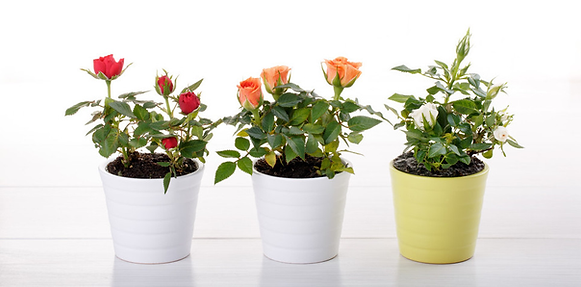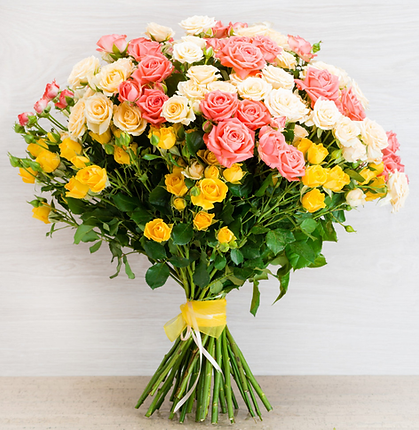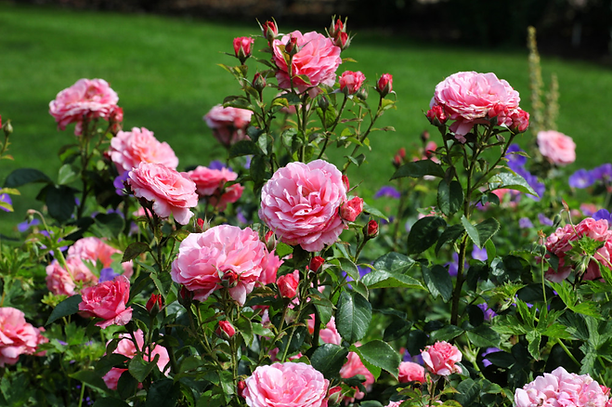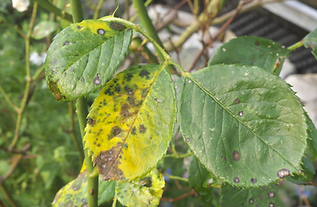
I’m sure you know what a rose is, but how is it different from a spray rose? Are they sprayed with something? LOL! Actually, no. Read on to learn not only what a spray rose is, but how to grow them, their different varieties, and what to do with them.
(Some of the links within this post are affiliate links on which I receive a small compensation from the sale of certain items with no extra cost to you.)
(As an Amazon Associate I earn from qualifying purchases.)
What is a Spray Rose?
Roses produce main stems called penduncles. On a standard rose bush, you have one long penduncle per rose bud; hence the single-stemmed rose. On spray roses each penduncle produces multiple smaller stems called pedicles. Each pedicle then produces one bud.
A spray rose blossom is a miniature standard rose on one penduncle that fans out producing many pedicles with multiple small buds. This process is known as inflorescence. Each grouping of pedicles can contain from three to five flowers. The word “spray” refers to abundance. Spray roses have an abundance of blossoms, hence the name.
Varieties of Spray Roses
There are many varieties of spray roses. They are in the Rosaceae family which includes all roses, but come in different colors and forms. Spray roses are sometimes referred to as miniature roses or sweetheart roses because they add a bit of romance to the atmosphere, or fluoribunda roses due to the abundance of blossoms on a major stem.
Miniature Roses
Miniature roses are the smallest variety of spray roses. They grow 10 to 24 inches in height and produce a one and a half inch diameter blossom. Miniature roses are not often used as cut flowers but are nice to display in a pot indoors near a window.

Florist Spray Roses
Florist spray rose plants are a little larger than the miniatures, however they too are sometimes referred to as miniatures. The florist type can be grown in pots and are frequently used as cut flowers. The stem of the rose, which is between 12 and 36 inches long, is shorter than the common rose, yet longer than miniatures.

Floribunda Rose Bushes
Still other spray roses present themselves as bushes. Many varieties of these bushes bloom from spring well into the fall. The bush is relatively small and will grow to only three or four feet tall.
Their blossoms are wonderful for tiny vases, as they have very short stems, and look nice displayed on a bathroom vanity, a side table in a guest room or next to a window in the kitchen. They have a wonderful aroma, so it’s nice to plant these next to a door or on a walkway.

As compared to a larger rose, all spray rose blossoms are more tightly wrapped and compact. Their flowers range from single blossoms with four to eight petals to semi-doubles with 15 to 25 petals, or doubles with 25 to 45 petals. The blooms are very dainty and are usually one to one and a half inches in diameter. They will last up to a week or slightly longer in a vase if they are maintained well.
Click here for more information on cut flowers.
Spray roses range in color from whites, to various pinks and reds and purple.
How to Grow Spray Roses
Spray roses are similar to standard roses. They prefer at least four to six hours of full sunlight. If you plant them in the shade, they will not bloom as profusely as if in full sun and will become prone to disease. If you live in a hot environment, plant them where they will be protected from the most intense afternoon sunlight.
Spray roses prefer well-drained soil that is amended with organic matter.
Two Main Types of Spray Roses
If you go to a nursery to purchase spray roses, you will see them packaged in 2 ways.
1. Bare Root
The most economical way to purchase spray roses is to buy them bare-rooted. They are sold with roots packed in peat moss to keep the roots moist. The plant is either dormant or just beginning to blossom. It is usually sold in early spring and if purchased at this stage of life will take longer to mature.
You can plant them from early spring into May to give them time to establish their roots and bloom for the summer. Do not plant them when the ground is soggy, or if you’re in a drought, or when the ground is frozen.
Steps for Planting Bare-Rooted Roses
1. Rehydrate your rose roots in a bucket of water for about two hours.
2. Using a garden fork, remove any weeds, rocks, stones, or debris from the area where you want to plant the bush.
3. Dig a hole approximately 16 inches wide by 16 inches deep using a spade shovel to accommodate the roots.
4. Break up any large chunks of soil and, using your hands, mix in either rotted manure or compost to the bottom of the hole and to the soil that was dug out.
5. Remove the rose roots from the bucket of water and, while holding it over the hole, sprinkle it with mycorrhizal fungi (sold at Amazon) to enhance vigorous growth, produce more blossoms, and help increase the plant’s tolerance to environmental extremes.
(The Symbiotic Relationship Between Plants and Mycorrhizal Fungi
When roots of plants are under mild nutritional stress, they release chemical cues that stimulate mycorrhizal growth. This fungi then penetrates the cell walls of the plant’s roots and helps the plant seek out and find more nutrition and water in the ground. Since the fungus is non-photosynthetic, it cannot produce food for itself. Therefore its rose partner, transfers nutrients back to the fungus. Everyone is happy!)
6. Place the bare roots in the center of the hole and backfill using the amended soil. Gently tap down the soil with your foot. The bottom of the stems should be two inches below the surface of the soil.
7. Water thoroughly. Here is a guide from “David Austin” showing how much water to use.
- Shrub roses – 1 gallon
- Climbing roses – 2 gallons
- Rambling roses – 2 gallons
- Standard tree roses – 2 gallons
- Roses in pots – 1 gallon
2. Container Plant
The more expensive way to purchase roses is plants grown in a container. These will be more mature plants and will achieve maturity sooner than bare-rooted plants.
Steps for Planting Container Plants
1. Dig a hole twice the width of the pot, but not any deeper.
2. Amend the soil with an organic, well-drained soil mix.
3. Carefully remove the bush from the container and gently untangle any roots that have wrapped around each other.
4. Place the plant in the hole and back fill with the amended soil. While pushing down the soil with your fingers, evenly distribute it around the roots to try and eliminate any air pockets.
5. Then water it well.
6. Mulch around the base of a rose bush to regulate the soil temperature, protect the roots and keep them moist, and deter the growth of weeds. Three inches of natural mulch is recommended.
Care Tips For Spray Roses
Pruning
In order to keep your rose bush looking fresh and full of blossoms, pruning will have to be done periodically. When you see the plant lagging in growth and looking unhealthy, give it a haircut.
Using sharp, clean hand clippers, carefully remove any dead or weak branches. Trim above the nodes in early spring and after a penduncle’s blossoms have faded. This is a form of deadheading. Be careful not to cut any new growth.
Clearing out dead growth will allow for more even air flow, preventing the onset of disease.
Watering
Rose bushes enjoy water. Water them deeply once a week, more during a drought. Use a soaker hose to allow the roots to become thoroughly watered and the leaves to remain dry. This will enable the roots to grow deep into the soil where there is more moisture.
Fertilizer
Floribundas require plenty of fertilizer since they produce an abundance of blossoms. At the first growth in the spring, start a routine of feeding your plant every six weeks. I like to mark the date on my calendar to remind me when to refertilize my roses.
As a beginner gardener, you may be overwhelmed with which tools to purchase. For more information on basic gardening tools, read Best Garden Tools For Beginners.

Diseases of Roses
Some common diseases of roses include powdery mildew, downy mildew, black spot, rust, blight, canker, crown gall, mosaic, and winter injury.
If your plant is diseased, remove any diseased canes (stalks) and leaves in the beginning of the season and during the growing season. In the fall remove any dead and diseased limbs or leaves under the bush. If the disease is severe enough, choose a natural fungicide that controls black spot and powdery mildew. For more on rose diseases, check out The Connecticut Agricultural Experiment Station.
A Rose by any Other Name Would Smell as Sweet
Floribundas have a wonderful, sweet perfume fragrance. If you would like to have the wonderful aroma waft into your home, plant them close to an open door.
List of Fragrant Floribundas
- Sunsprite: dark yellow with a lemony fragrance
- Escapade: mauve blend
- Sheila’s Perfume: yellow blend
- Shocking Blue: quite intense aroma
====<Purchase Floribunda Roses From Etsy>====
What is a Spray Rose?
A spray rose is a rose much smaller than your standard rose and one that produces multiple roses on one major stem. They are widely used in random bouquets, center pieces, and bridal bouquets.
Spray roses are a wonderful alternative to the large variety in your landscape. If you follow the steps above on how to grow spray roses, you will enhance your garden with not only a beautiful display of dainty roses, but a glorious aroma drifting throughout your entire garden.
I hope you enjoyed this post. Please leave a comment below and please share it with friends and family.
Happy Gardening!
Nina

